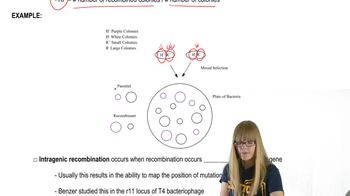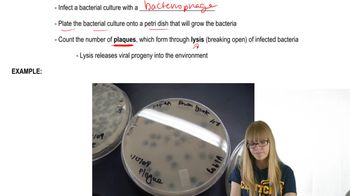Table of contents
- 1. Introduction to Genetics51m
- 2. Mendel's Laws of Inheritance3h 37m
- 3. Extensions to Mendelian Inheritance2h 41m
- 4. Genetic Mapping and Linkage2h 28m
- 5. Genetics of Bacteria and Viruses1h 21m
- 6. Chromosomal Variation1h 48m
- 7. DNA and Chromosome Structure56m
- 8. DNA Replication1h 10m
- 9. Mitosis and Meiosis1h 34m
- 10. Transcription1h 0m
- 11. Translation58m
- 12. Gene Regulation in Prokaryotes1h 19m
- 13. Gene Regulation in Eukaryotes44m
- 14. Genetic Control of Development44m
- 15. Genomes and Genomics1h 50m
- 16. Transposable Elements47m
- 17. Mutation, Repair, and Recombination1h 6m
- 18. Molecular Genetic Tools19m
- 19. Cancer Genetics29m
- 20. Quantitative Genetics1h 26m
- 21. Population Genetics50m
- 22. Evolutionary Genetics29m
5. Genetics of Bacteria and Viruses
Bacteriophage Genetics
Problem 2
Textbook Question
Write a short summary that contrasts how recombination occurs in bacteria and bacteriophages.
 Verified step by step guidance
Verified step by step guidance1
Recombination in bacteria typically occurs through processes such as transformation, transduction, and conjugation. In transformation, bacteria take up foreign DNA from their environment. In transduction, bacteriophages (viruses that infect bacteria) transfer DNA between bacteria. In conjugation, DNA is transferred directly between bacteria through a pilus.
In bacteriophages, recombination occurs during the infection cycle. When a bacteriophage infects a bacterial cell, it can integrate its DNA into the host genome, forming a prophage. This integration can lead to genetic recombination if the prophage excises imprecisely, taking some bacterial genes with it.
Bacterial recombination often involves homologous recombination, where similar or identical DNA sequences are exchanged between different DNA molecules. This process is facilitated by proteins such as RecA in bacteria.
In bacteriophages, recombination can also occur through site-specific recombination, where specific sequences in the phage and bacterial DNA are recognized and recombined by specialized enzymes, such as integrases.
Overall, while both bacteria and bacteriophages can undergo recombination, the mechanisms and contexts in which they occur differ, with bacteria often engaging in recombination to acquire new traits and bacteriophages using recombination as part of their lifecycle to propagate and diversify.
Recommended similar problem, with video answer:
 Verified Solution
Verified SolutionThis video solution was recommended by our tutors as helpful for the problem above
Video duration:
2mPlay a video:
Was this helpful?
Key Concepts
Here are the essential concepts you must grasp in order to answer the question correctly.
Recombination in Bacteria
Recombination in bacteria primarily occurs through three mechanisms: transformation, transduction, and conjugation. Transformation involves the uptake of free DNA from the environment, transduction is mediated by bacteriophages that transfer genetic material between bacteria, and conjugation requires direct cell-to-cell contact to transfer plasmids. These processes allow for genetic diversity and adaptation in bacterial populations.
Recommended video:
Guided course

Recombination after Single Strand Breaks
Recombination in Bacteriophages
Bacteriophages, or phages, can undergo recombination through processes such as generalized and specialized transduction. In generalized transduction, any bacterial gene can be transferred when a phage mistakenly packages bacterial DNA during replication. Specialized transduction occurs when a phage integrates into the bacterial genome and, upon excision, carries adjacent bacterial genes, facilitating the exchange of specific genetic traits.
Recommended video:
Guided course

Mapping Bacteriophages
Genetic Diversity
Both bacteria and bacteriophages contribute to genetic diversity through recombination, which is essential for evolution and adaptation. In bacteria, recombination mechanisms enhance genetic variation, allowing populations to respond to environmental changes. In bacteriophages, recombination can lead to the emergence of new phage strains, influencing bacterial evolution and the dynamics of microbial ecosystems.
Recommended video:
Guided course

Descriptive Genetics

 3:44m
3:44mWatch next
Master Plaques and Experiments with a bite sized video explanation from Kylia Goodner
Start learningRelated Videos
Related Practice


